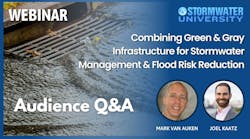In June of this year, the Buffalo Sewer Authority closed on an Environmental Impact Bond (EIB) worth $54 million — the country’s largest to date. The bond supports Buffalo’s Rain Check 2.0 Initiative to finance green infrastructure (GI) from easements and public land within the city’s combined sewer overflow (CSO) basins. The initiative is anticipated to lower stormwater fees for rate payers and triple the authority’s pace of GI projects.
Where Did These Bonds Come From?
The current momentum of EIBs is thanks to Quantified Ventures, a capital firm that has been the driving force structuring all major EIBs in the industry.
The first EIB moved from theory to practice in Washington, D.C. in 2016 for $25 million, with Quantified Ventures structuring the bond. Since then, the firm has structured major stormwater EIBs for Atlanta, Ga. ($14 million); Baltimore, Md. ($6.2 million); Hampton, Va. ($12 million); and now Buffalo, N.Y. ($54 million). The firm still has many other EIBs currently in production, both large and small.
“It takes a lot to move beyond the business-as-usual approach to thinking about green infrastructure as a solution as opposed to gray ,” said Ben Cohen, director of urban and coastal resilience for Quantified Ventures. “At the time we started with D.C. Water, that was fairly novel as a stormwater management approach.”
Often, an EIB follows a kind of pay for success (PFS) structuring. Originally practiced through social impact bonds in the United Kingdom in 2010, PFS financing is an outcomes-based model where the municipality can repay investors based on the outcomes of a program.
The purpose of a PFS model is to shift financial risk away from the municipality and toward investors. The government essentially pays according to outcomes of an investment, and so investors then have a strong interest in supporting programs with higher chances of success.
While the social impact programs in Europe faced criticism for inefficiencies in spending, random control trials and complex evaluation methodologies, these criticisms don’t seem to apply to EIBs.
“We like to take a pretty efficient approach over thinking about that outcomes evaluation, and make sure that something is cost-effective and relatively easy to do,” said Cohen. “That innovation is part of what enabled us to make impact bonds into actual municipal bonds that are being structured for things like green infrastructure.”
What is an EIB?
The structure of today’s EIB is unique among bond options, thanks to the importance of outcomes in its structure.
“What’s special about the Environmental Impact Bond is that it includes an outcome validation as part of the bond offering,” said Cohen. “It can be used just for simple outcomes and impact reporting and disclosure to investors, and it can also impact the way that some of the bond terms work.”
The strength of this approach lies in its ability to lean on private interests to foster new practices. With a lower financial risk for the municipality, innovative social programs can pass traditional funding roadblocks. And so, with the recent rise in innovations through GI, the EIB became an ideal financing solution for municipal stormwater management.
Who Should Consider an EIB?
While this type of bond has been mostly known for its work in large, highly-urbanized areas, Cohen thinks that it could be appropriate for municipalities of any size.
“I think when we started doing these Environmental Impact Bonds, we were working with larger, well-resourced cities like Atlanta and D.C., but we’ve been working a lot more recently with smaller, perhaps less well-resourced cities,” said Cohen.
In fact, he said, outcomes-based terms may be more attractive to less well-resourced cities — “because it offers a way to hedge against uncertainty around how innovative projects are going to perform.”
EIBs Vary in Structure
While all EIBs include outcome validation as part of the bond offering, each bond is very different in terms of its outcome measurements and bond payments.
“I think what we continue to learn is that there’s no one-size-fits all solution,” said Cohen. “We’ve seen that in some of the variation in how the outcomes-based terms have come out in different forms that we’ve structured.”
For example, Cohen shared, D.C. used a three-tiered performance payment structure, Atlanta used a two-tiered structure and Buffalo instead used an outcomes-based call feature.
D.C.’s three-tiered structure could either pay for the program’s over performance or require payment for its under performance. Essentially, if the GI helped reduce runoff by less than 18.6 percent, investors would make a Risk Share Payment to DC Water of $3.3 million. If the GI reduced runoff by more than 41.3 percent, DC Water would make an Outcome Payment to investors of $3.3 million.
Buffalo’s outcomes-based call feature is a bit different because it doesn’t need to explore the effectiveness of GI. Instead, if Buffalo successfully manages 200 acres of impervious area through GI by year seven, the city has the option to call the bond early and either refinance it or just pay it down. In that same year, a portion of bonds will also start increasing in coupon rate. This feature ensures that, if the municipality executes its program correctly, Buffalo has much more flexibility in regards to its debt service — but, if it fails to execute the program in time, Buffalo will have to pay its investors a greater share.
Quantified Ventures is also working on a number of bonds where there’s no outcomes-based payment structure at all, but rather just disclosure and reporting. These bonds are still unique among bonds and represent a significant shift in current investing practices. This is because the bonds’ disclosure and reporting will still enable issuers to tap into a growing environmental, social and corporate governance (ESG) market.
After Buffalo issued its bond in June, Quantified Ventures had finished its work with the Buffalo Sewer Authority. However, the groups still keep in touch and have a good working relationship: the executive director of the Buffalo Sewer Authority even presented on their work together at StormCon in September. SW
About the Author: Jeremy Wolfe is Assistant Editor for Stormwater magazine. Email him at [email protected].
Published in Stormwater magazine, November 2021.







